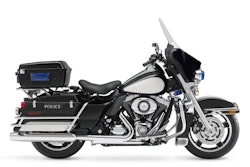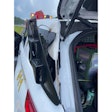The police patrol vehicle market is not known for revolutionary innovation. Most patrol car models tend to stay in production for years, even a decade or more. And during the course of their production very little changes in their interior or exterior designs. Oh, maybe a manufacturer will add a safety feature or a comfort feature to a 10-year-old model, but when it comes to real change police car manufacturers have generally moved at glacial speed.
But that business model is now metamorphosing in response to a rapidly evolving automobile market. The domestic auto manufacturers that have ruled the American law enforcement market are in turmoil. And with the price of oil and refined gasoline soaring and many people voicing concerns about the environmental impact of the internal combustion engine, every car manufacturer is rethinking its designs.
This means that the once staid patrol car market is becoming turbulent and more innovative. It used to be that a car company would make a few performance and safety adjustments to its most powerful full-sized sedans, beef up the suspension, tone down the luxury, and it would have a patrol vehicle.
Some companies still work this way. But others are searching for a new business model as they prepare to launch the next generation of police vehicles.
Chevy plans to be first out of the gate in the next generation patrol car race, launching the Caprice PPV in 2011. Unveiled at the recent International Association of Chiefs of Police show in Denver, the Caprice PPV is a true 21st century patrol car that really only shares two characteristics with its early 1990s' namesake: the model name and rear-wheel drive.
In the October 2006 issue of POLICE, former patrol officer Steve Rothstein expressed his fond feelings for his old Caprice patrol car, which he lovingly called "Shamu" after the Sea World killer whale. The Caprice Classic was a large car with a heady engine. Maybe that's why so many cops liked it so much. The new Caprice is very powerful, and it's roomy, but it has very little resemblance to the killer whale-sized Caprice of the past.
The 2011 Caprice is not so much an update of the 1990s' Caprice as it is a sedan version of Chevy's new Camaro. Which is no surprise because it's built on the same Holden chassis as the Camaro and the now-defunct Pontiac G8. It's also Camaro fast. Chevy says the 6.0-liter V8 version of the Caprice PPV will generate 355 horsepower and 384 lb-ft of torque. What that means is a sub-six-second 0-60 acceleration.
In many cars, performance comes at the price of fuel economy. But Chevy knows that won't fly later this decade when gas prices are sure to soar, so the Caprice PPV features GM's Active Fuel Management. This technology improves fuel economy by dropping out four of the engine's eight cylinders at cruising speed, making the car essentially a V4.
Chevy likes to say that the Caprice PPV is built specifically for the police market. And that's kinda true. The new Caprice PPV is based on the Caprice sedan sold in the Middle East, but there are no current plans to sell it in the United States.
Also, the police version of the Caprice was outfitted specifically to meet the needs of law enforcement. For example, the seats are designed with cutouts to accommodate officers wearing duty belts and duty equipment. "One of the things we've heard most about as we've been showing the Caprice to officers is the seats," says Joyce Mattman, director of commercial products for GM. "We've had officers ask if they can buy the seats for their office use."
Another law enforcement specific feature on the Caprice PPV is the car's dual battery system. Both the primary and the secondary battery are housed in the trunk. The primary is wired into the car's ignition and other essential systems. The secondary battery powers the emergency lights and emergency equipment. This has the potential to save agencies huge amounts of fuel, as the car will not have to idle at accident scenes to power its emergency lights.
Such features have made the Caprice PPV a hit at police trade shows. At IACP in November, officers gathered around the car and snapped numerous photos with cell phones and digital cameras. Interviewed at the show, Sgt. Noel Clason, fleet manager of the Bloomfield Hills (Mich.) Police Department, said the Caprice will be a comfortable workspace for officers. "The legroom is excellent," he said. Then he demonstrated that he could sit in the driver seat wearing his hat with no problem.
The introduction of the Caprice PPV does not mean the end of Chevy's current police workhorse, the Impala PPV. "This fills in our police product lineup," says Mattman. "With the Caprice PPV, we will have a vehicle for every need in this market: the front-wheel-drive Impala V6, the rear-wheel-drive Caprice PPV V8, and the Tahoe SUV, the only police-rated SUV on the market."
Carbon Motors is by far the most unusual contender in the next generation patrol car race. It only makes one model of automobile, and it sees itself as more a government contractor like a defense company than a car company.
The Carbon Motors E7 is scheduled to hit the streets in 2012, and it will be a very different kind of patrol car. Built specifically and only for law enforcement, the E7 will be powered by a 3.0-liter, turbocharged clean diesel engine that will generate 300 horsepower and 420 ft-lbs of torque. Carbon's executives say the car will accelerate from 0-60 mph in 6.5 seconds and reach a top speed of 155 mph. Just as importantly, the E7's 18-inch wheels have brake rotors big and robust enough to go from 60 mph to stopped in 125 feet.
Unlike most patrol cars, the E7 will be delivered to the buyer for one price with all equipment pre-installed. Carbon says it will be price competitive based on the cost of its competitors' vehicles and the systems that agencies have to buy for them to make them patrol ready.
Company founder and former Texas cop Stacey Dean Stephens says that another selling point for the E7 will be its durability. Carbon is pledging that the E7 will keep cruising for 250,000 miles, more than twice the industry standard. Maintenance for the vehicles will be handled through authorized Carbon Service Centers, including the fleet operations centers of large police agencies.
Stephens cites Chicago as an example of a city that has facilities capable of servicing the vehicles of surrounding agencies. "They have a tremendous maintenance facility and, if they set that up as a Carbon Service Center, then they are providing services to other agencies and providing themselves with an additional stream of revenue."
Carbon Motors is setting up its production facility in a vacant Visteon plant in Connorsville, Ill. At presstime, the company received tentative approval on a $310 million U.S. Department of Energy loan.
Sunsetting the Crown Vic
Last year Ford announced that 2011 will be the final model year for production of the Crown Victoria Police Interceptor (CVPI). The market-dominant CVPI has been one of the most successful patrol cars in history, remaining in production for nine years beginning in 1992.
Ford is being cagey about its plans for a CVPI replacement, saying only that the new model will be announced by April 1 of this year.
For 2010, the CVPI has some minor but interesting revisions, including a new optional fire suppression system and an LED light package. Other options available include ballistic door panels, a trunk pack, and a street appearance package.
Dodge in Transition
Without a doubt, the Dodge Charger Police Package has been an extremely popular patrol car, especially with highway patrols. The muscular 340-horsepower hemi-powered V8 boasts intimidating looks and teeth-rattling acceleration. It's been clocked at 6.2 seconds from 0-60 mph and can reach 125 mph in 43 seconds. For more routine patrol duties, the Charger is available in a 3.5-liter V6.
It's uncertain what Dodge plans for the police market going forward. Parent company Chrysler is no longer in control of its own destiny. It filed for Chapter 11 in April 2009 and is now called the New Chrysler.
The New Chrysler is an amalgam of the old Chrysler and Fiat, which owns 20 percent of the company and essentially has an option to buy controlling interest. What will come from the New Chrysler is anybody's guess but odds are it will not be police patrol sedans like the Charger.
The U.S. government is pressuring Chrysler to make green cars that will be smaller and offer substantially improved fuel economy. The Dodge Charger Police Package is many things, but it is not a gas sipper.
Corrections
In this story, we made several errors in our coverage of the Dodge Charger. The U.S. government's investment in Chrysler and Fiat's 20 percent ownership of the company will not affect the company's plans for updating the Dodge Charger police vehicle.
The Detroit News recently published a "spy" photo of the 2011 Dodge Charger. The new Charger will reportedly be available with a Pentastar 3.6-litre V-6 engine, a 5.7-liter Hemi V-8, or a 6.4-liter Hemi V-8. Dodge says a police version of the new Charger will be released very soon after the launch of the civilian models.
We also stated that the Charger is not a "gas sipper." Dodge Charger patrol vehicles are actually quite fuel efficient. The 3.5-liter version offers the best gas mileage of any patrol vehicle: 17.25 miles per gallon city and 25 highway. The 5.7-liter Hemi is also quite economical offering EPA ratings of 16 mpg city and 25 highway. POLICE apologizes for these errors.
Vehicle Manufacturers:



















